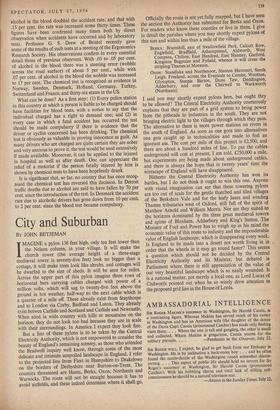Drink and Road • Accidents
BY DR. SOMERVILLE HASTINGS, MP MANY more road accidents are due to drink than is generally supposed. A committee appointed by the British Medical Association reported in 1954 that 'People under the influence of alcohol are responsible for several thousand road accidents every year in spite of the fact that the official records show a much smaller number.' Dr. N. I. Spriggs, a police surgeon, in a letter to the British Medical Journal of April 30. 1955, analysed the road casualties in Leicestershire and Rutland in 1953 and reached the con- clusion that at least half of the fatal accidents after 10 p.m. in that area were due to drink in motorists, cyclists or pedestrians. The Statistical Reports of the Chief Medical Officer of the City of New York for 1947, 1948. 1949 and 1950 state that of those killed by road accidents in this area about half were tested for alcohol in the tissues after death, and of these 40 per cent. had .1 per cent. of alcohol or more. As will be shown later, anything more than half this amount may adversely affect a motorist's ability to drive safely.
The dangerous people on the roads are not those obviously drunk but those who have 'had a little.' For even small quantities of alcohol are liable not only to interfere with judge- ment and caution but may also tend to limit the peripheral vision and increase reaction time, that is the interval between seeing and doing; for instance, noticing a person step on to the road and applying the brakes to the car.
But the law says something very different. 'Driving or attempting to drive or being in charge of a motor-car on a road or other public place while under the influence of drink or drugs to such an extent as to be incapable of being in proper control of the vehicle' is an offence under Section 15 of the Road Traffic Act 1930. What could possibly be more vague? What is 'proper control' and to what extent must one be under the influence of alcohol to lose it? How many doctors can say with certainty in every case after an examination in a police station whether the individual examined was or was not 'incapable of having proper control of a vehicle' at the time that the accident occurred, and—what may be even more difficult—stand up to cross-examination on it by a clever lawyer?
It is because of such difficulties that doctors and research workers have been searching for a mote certain test. It is comparatively easy to ascertain the percentage of alcohol in the blood; but the question arises, what percentage is likely to result in dangerous driving on the roads? Between 1947 and 1952 a committee sponsored by the Swedish Government carried out 3.000 tests and reached the con- clusion that amounts of between .03 and .05 per cent. of alcohol in the blood doubled the accident rate, and that with .15 per cent. the rate was. increased some thirty times. These figures have been confirmed many times both by direct observation when accidents have occurred and by laboratory tests. Professor G. S. Drew of Bristol recently gave some of the results of such tests at a meeting of the Ergonomics Research Society. His observations confirm in every essential detail those of previous observers. With .03 to .05 per cent. of alcohol in the blood there was a steering error (wobble across the road surface) of about 5 per cent., while with .07 per cent. of alcohol in the blood the wobble was increased to 17 per cent. The chemical test is recognised as evidence in Norway, Sweden, Denmark, Holland, Germany, Turkey, Switzerland and France, and thirty-six states in the US.
What can be done? As a first step : (1) Every police station in this country at which a person is liable to be charged should have facilities for blood tests, with a notice to say that the individual charged has a right to demand one; and (2) in every case in which a fatal accident has occurred the test should be made compulsory if there is evidence that the driver or cyclist concerned has been drinking. The chemical test is obviously as valuable in proving innocence as guilt. As many drivers who are charged are quite certain they are sober and very anxious to prove it, the test would be used extensively if made available. Moreover, it can be applied to the injured in hospital as well as after death. One can appreciate the relief of a motorist if the person fatally injured by him is shown by chemical tests to have been hopelessly drunk.
It is significant that, so far, no country that has once recog- nised the chemical test has reversed this decision. In Detroit traffic deaths due to alcohol are said to have fallen by 70 per cent. since the introduction of the test. In Denmark the accident rate due to alcoholic drivers has gone down from 10 per cent. to 2 per cent. since the blood test became compulsory.



































 Previous page
Previous page